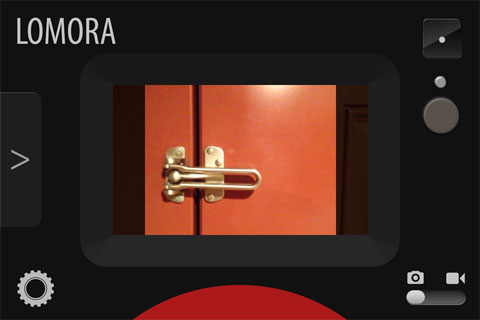 iPhone lomography app Lomora has a new update. Lomora 3 was just released and is a major overhaul of the app. New users may like the combinations of Lomora’s filter set and the many of the new options. Previous users may like them, too, but will have to shell out three bucks to find out. This is a paid upgrade.
iPhone lomography app Lomora has a new update. Lomora 3 was just released and is a major overhaul of the app. New users may like the combinations of Lomora’s filter set and the many of the new options. Previous users may like them, too, but will have to shell out three bucks to find out. This is a paid upgrade.
It’s an ambitious update. Many of the new features are well done and great. Many others seem thrown together and poorly coded. And I’m puzzled by some of the app’s changes.
Read past the jump for more details. >;>;>;
Once you get past the Sham Wow-like pitch of the app store description, Lomora is a good LOMO-style camera app. Its film-based filter set is lush and colorful. The new update is a mixed bag. It adds a lot more features and functionality over previous versions of the app, but poorly implements several of the new features and inexplicably removes some of the films that made Lomora 2 an interesting app to shoot with.

The new user interface makes accessing the numerous new features easy to use. It’s mostly gesture-based and lets you maneuver though most settings with your thumb.
And there are a ton of new settings. In addition to square format, Lomora 3 now also shoots 3:2 — the aspect ration of standard 35mm film — and 16:9. In addition to single frame exposures, there are several other LOMO-style frame options as well, including multiple exposures, super sampler-style multiple image photos, and split-frame images. Although the new sampler frames are cool in theory especially the split frame, they are very poorly implemented. They shoot pretty quickly, but the resulting images are 640×426 — low res — and pretty much unusable for most purposes.
In addition to the Standard single shot mode, Lomora 3 adds two additonal shooting modes — Double Exposure and Light Painting. The Double Exposure mode works as expected. The app allowed me to take two exposures and it merged them both using a standard multiply blend. Double Exposure images saved at full resolution. The new Light Painting mode is just about worthless. There is little control over the exposure and it saves again at a tiny 640×426 or 480×480 pixel resolution — that’s less than an iPhone 4 screen grab.
Lomora 3 now also has several new color “filters” which add interesting color effects to the films or changes the contrast in the black and while filter. The new filters add functionality to help offset the film filters that have been deleted.
Vignette is now adjustable and you can over or under expose your images +/- 2 f-stops. I like both features. Lomora’s vignettes have always looked good. I like that now the intensity is adjustable.
Color in Lomora has its own look and photos still look very Lomora-eque. Colors are vivid, often overdone, and contrasts are stark. Colors are too intense and saturated to be an authentic LOMO recreation, but have image qualities that make them a signature feature of Lomora.
Once you find combinations you like, Lomora now lets you easily save them as presets, a great feature to help more easily manage the number of new options the app now has.
Lomora supports full-res 3264×2176 full frame 3:2 images on an iPhone 4S and full res 2448×2448 saves in square format. With this update, you can now also shoot video with Lomora’s rich, LOMO effects.
Lomora 3 only features eight of the films from previous versions — fewer than the 18 found in Lomora 2 and something that owners of previous versions will miss. Gone are the B/b, C/B, R/P, Y/O, etc. films which yielded some of the app’s interesting color combinations. This is the change that perplexes me the most about this version of the app. The extra films wouldn’t clutter the interface and there are no trademark violations in the deleted films. I don’t know why they were deleted but it’s not a good change in an otherwise good update. I’m a little miffed that they’re gone.
Also gone is the retro analog style of the previous user interface. In its place is a leaner, more modern UI that lacks the texture one expects from a LOMO-style app. While very clean and functional, the new UI is also a little sterile compared to the previous version. With all the new film and filter options, Lomora 3 could also use a Hipstamatic style “shake to randomize” feature.
I found a few interface quirks. Lomora 3 has a new Big Button full screen shutter release that gets in the way of its separate focus and exposure targets. And the button to activate the iPhone’s hardware flash is very, very close to the app’s shutter button. In testing the app, I accidentally triggered the flash several times.
The new video function is not impressive at all. While it renders video with Lomora effects fairly quickly, it only supports standard 640×480 resolution at 30 fps on an iPhone 4S. There are no options for any high-def video at all. Lomora 3’s video function is good for taking moving snapshots for sharing to Facebook, but more serious videographers will be frustrated by the lack of settings and options. This is basically a toy video component.
The developer of Lomora has sometimes had a rocky relationship with iPhonegraphers that was tenously smoothed over with Lomora 2. The pricing for Lomora 3 is sure to reopen old wounds and potential hack previous owners off. While all eight of the app’s films and the complete set of tools and filters of Lomora are included in the $2.99 price — there are no in-app purchases for additional films — Lomora 3 will cost previous users the full three bucks to upgrade. No free upgrade path is being offered like the recent King Camera upgrade.
I am skeptical of any iOS apps that charge previous users to update while only offering a few new features and minimal user experience improvements. Also, because of the missteps in the rollout of the original Lomora, I’m not inclined to give this developer a pass on anything.
Is the Lomora 3 update worth spending another $2.99? This a a major update — an extensively reworked app. If the new features worked well, the upgrade price would be justified. But there’s a lot wrong with the new features that render them all but unusable. The new filters and aspect ratios are nice, but don’t justify the additional $3. While the new video function and camera options are compelling, many are not implemented well enough to use as a reason for buying the app.
Lomora 2 (  ) is still available in the App Store for $2.99 and may be an option for iPhoneographers who want the additional films and don’t mind not having Lomora 3’s additional new features. Because the App Store sees this as a new app, you’ll be able to keep both Lomara 2 and 3 on your iPhone.
) is still available in the App Store for $2.99 and may be an option for iPhoneographers who want the additional films and don’t mind not having Lomora 3’s additional new features. Because the App Store sees this as a new app, you’ll be able to keep both Lomara 2 and 3 on your iPhone.
Label Lomora 3 as another LOMO-style app, but its oversaturated color effects are faithful to the spirit of Lomography. But Lomora 3 is a hit-or-miss upgrade. While not everyone will be pleased with this update, new users may enjoy experimenting with Lomora 3’s various films and the tools that work. Overall, I think previous users who spring for the upgrade will like the new tools and features of version 3, particularly the new filters. For me, though, this is not an essential update. Despite its lack of features when compared to the version 3, Lomora 2 at least works and to me is still the more attractive purchase.
Requirements: Compatible with iPhone 4, iPhone 4S, iPod touch (4th generation), iPad 2 Wi-Fi, and iPad 2 Wi-Fi + 3G.Requires iOS 5.0 or later.
=M=
…
~~~~



